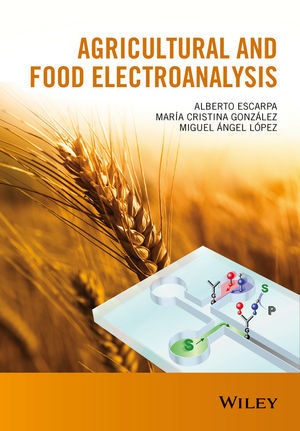Read more
Informationen zum Autor ALBERTO ESCARPA Analytical Chemistry, Physical Chemistry and Chemical Engineering Department, University of Alcala, Spain MARÍA CRISTINA GONZÁLEZ Analytical Chemistry, Physical Chemistry and Chemical Engineering Department, University of Alcala, Spain MIGUEL ÁNGEL LÓPEZ Analytical Chemistry, Physical Chemistry and Chemical Engineering Department, University of Alcala, Spain Klappentext Agricultural and Food Electroanalysis offers a comprehensive rationale of electroanalysis, revealing its enormous potential in agricultural food analysis. A unique approach is used which fills a gap in the literature by bringing in applications to everyday problems.This timely text presents in-depth descriptions about different electrochemical techniques following their basic principles, instrumentation and main applications. Such techniques offer invaluable features such as inherent miniaturization, high sensitivity and selectivity, low cost, independence of sample turbidity, high compatibility with modern technologies such as microchips and biosensors, and the use of exciting nanomaterials such as nanoparticles, nanotubes and nanowires.Due to the advantages that modern electroanalytical techniques bring to food analysis, and the huge importance and emphasis given today to food quality and safety, this comprehensive work will be an essential read for professionals and researchers working in analytical laboratories and development departments, and a valuable guide for students studying for careers in food science, technology and chemistry. Zusammenfassung Agricultural and Food Electroanalysis offers a comprehensive rationale of electroanalysis, revealing its enormous potential in agricultural food analysis. A unique approach is used which fills a gap in the literature by bringing in applications to everyday problems. Inhaltsverzeichnis List of Contributors xv Preface xix 1. Electroanalysis and Food Analysis 1 Paloma Yá¿nez-Sede¿no and José M. Pingarrón 1.1 Introduction and Adequacy of Electroanalysis for Food Analysis 1 1.2 Methodologies Related to Measurement Techniques 2 1.2.1 Continuous Detection Methods 2 1.2.2 Stripping Analysis 5 1.2.3 Potentiometry and Chronopotentiometry 7 1.2.4 Electronic Tongues 7 1.2.5 Impedance Spectroscopy 9 1.3 Electrochemical Sensors and Biosensors for Food Components 9 1.3.1 Molecularly Imprinted Electrodes 9 1.3.2 Enzyme Biosensors 10 1.3.3 Affinity Biosensors 12 1.4 Nanomaterials for Electrochemical Analysis of Food 14 1.5 Future Trends 16 Acknowledgments 16 References 16 Part I Electroanalytical Techniques in Batch and Continuous Systems in Food Analysis 21 2. Voltammetric Techniques 23 Sandra Mendoza, Erika Bustos, Juan Manr¿ýquez and Luis A. God¿ýnez 2.1 Introduction 23 2.2 An Overview of Sweep Potential Electrochemical Techniques 23 2.2.1 Linear Sweep Voltammetry/Cyclic Voltammetry 25 2.2.2 Pulse Voltammetry Techniques 27 2.2.3 Normal Pulse Voltammetry 27 2.2.4 Differential Pulse Voltammetry 28 2.2.5 Square Wave Voltammetry 28 2.2.6 Stripping Voltammetry 29 2.3 Applications of Voltammetric Techniques in Food Analysis 31 2.3.1 Food Contaminants: Heavy Metals, Pesticides, and Toxic Substances 31 2.3.2 Trace Essential Elements 35 2.3.3 Food Additives 35 2.3.4 Nutraceuticals: Phenolic Acids, Flavonoids, and Others 40 2.4 Concluding Remarks 44 Abbreviations 44 References 44 3. Flow-Injection Analysis with Electrochemical Detection 49 Fabiana Silva Felix and Lúcio Angnes 3.1 Introduction 49 3.2 Screening the Literature 51 3.3 Voltammetry under Flowing Stream 52

